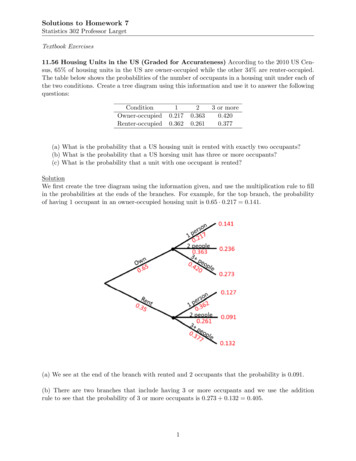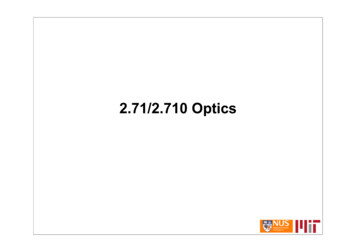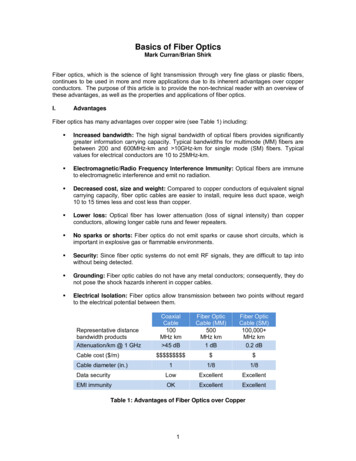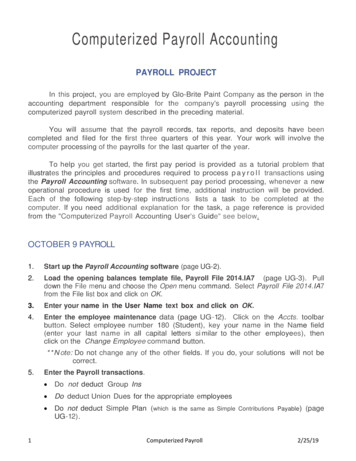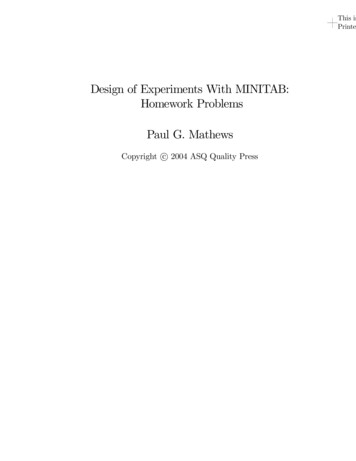
Transcription
Chapter 8Optics homework solutions - p1Prob 8.1(a) Verify that V (τ ) γ(τ ) . We have thatSig(τ ) aE [1 Re {γ(τ )}]The general pattern is that Re {γ(τ )} oscillates rapidly between γ(τ ) and γ(τ ) as τ changesa small amount, but that the amplitude of the oscillation γ(τ ) changes slowly in τ . We willshow this to be true in a bit but for now this allows us to writemax [Sig(τ )] aE [1 γ(τ ) ]andmin [Sig(τ )] aE [1 γ(τ ) ]Thusmax [Sig(τ )] min [Sig(τ )]max [Sig(τ )] min [Sig(τ )]aE [1 γ(τ ) ] aE [1 γ(τ ) ] aE [1 γ(τ ) ] aE [1 γ(τ ) ]2 γ(τ ) 2 γ(τ ) V (τ ) (b) Compute the coherence time ifI(ω0 )I(ω) 1 First we computeZ ZI(ω)dω I(ω0 ) 1 Z I(ω0 )ω ω0 ωFWHM /2 10 1 I(ω0 )eω ω0 ωFWHM /2 iω0 τZ I(ω0 )e iω0 τZ 2 e 1 2with b by Eq 0.56 withI(ω0 ) ω ω0 ωFWHM /2 2 dω1du u2 /b2 I(ω0 )π b eZ whileZI(ω)e iωτ dω iωτ ωFWHM2and u ω ω0a 0dωe i(ω ω0 )τ 2 dωω ω0 ωFWHM /2eiu( τ )du with1 u2 /b2 ab I(ω0 )e iω0 τ π b eb by Eq 0.56 with ωFWHM2and u ω ω0a τThusI(ω0 )e iω0 τ π b e ab I(ω0 )π b γ(τ ) e iω0 τ e ab e iω0 τ e This leads toZ ωFWHM2 τ γ(τ ) 2 dττc Z e ωFWHM τ dτ Z 20 e ωFWHM τ dτZ 2e u du ωFWHM2 ωFWHM0Now regarding the general characterization of γ(τ ). We start by assuming as always that I(ω)is significantly non-zero only near some value ω0 . So that I(ω) f (ω ω0 ) with f narrowlypeaked at zero. Then1
Chapter 8Optics homework solutions - p2Z I(ω)e iωτ dωZ iω0 τf (ω ω0 )e i(ω ω0 )τ dω e Z iω0 τf (u)e iuτ du eγ(τ ) e iω0 τ F (τ )where F is the Fourier transform of f . Because f (u) was narrowly peaked we know that F (τ )must be broadly peak, because that is how transform pairs work. Thus we see that γ(τ ) isexpected to be a rapidly oscillating function e iω0 τ modulated by the slowly varying functionF (τ ). Look at example 8.1 in the text for a concrete example of this general pattern.2
Chapter 8Optics homework solutions - p3Prob 8.2(a) From example 8.2 we haveV (τ ) e (τ /2T )andτc 22πTSo thatV (0) e0 1andV (τc ) e ( 2π/2)2 e π/2 0.21(b) · E 0 T 2 e T 2 (ω ω0 )2I(ω) 21 0 cE0soI(ω0 12 ωFWHM ) 12 I(ω0 )becomes1 2 0 cE0 0 T 2 e T·E21( 2 ωFWHM )2ore T2 1( 2 ωFWHM )211 2 2 0 cE0 0 T 2 e0·E12orT 2 ( 12 ωFWHM )2 ln 2 ln 212 ωFWHM T 2 ln 2 ωFWHM Tand so λFWHMrr λ20ln 2 λ202 ln 2 λ20λ20 2 ln 2 ωFWHM 2 2πc2πc T2π c 2πTπ c3
Chapter 8Optics homework solutions - p4Prob 8.3By definition of E(ω)Z1E(t)eiωt dtE(ω) 2πZ1 E0 ei(k0 z ω0 t) eiωt dt2πZik0 z 1 ei(ω ω0 )t dt E0 e2πZ1 E0 eik0 z ei(ω ω0 )t dt2π E0 eik0 z 2π δ(ω ω0 ) I(ω) 21 0 nc E(ω) 2 I(ω) 21 0 ncE02 2π δ 2 (ω ω0 )Thus we can computeRI(ω)e iωτ dωRI(ω)dωRδ 2 (ω ω0 )e iωτ dωRδ 2 (ω ω0 )dωRδ(ω ω0 )δ(ω ω0 )e iωτ dωRδ(ω ω0 )δ(ω ω0 )dωγ(τ ) δ(ω0 ω0 )e iω0 τδ(ω0 ω0 ) e iω0 τThus Re {γ(τ )} cos(ω0 τ ).4
Chapter 8Optics homework solutions - p5Prob 8.4In problem 8.1 we computedγ(τ ) e iω0 τ e ωFWHM2So thatRe {γ(τ )} cos(ω0 τ )e τ ωFWHM2 τ and by equation 8.18 the mean intensity at the detector will beih ωFWHM τ 2Sig(τ ) 2hI(t)it 1 cos(ω0 τ )e ω0 21 X Sig(τ ) 2hI(t)it 1 cosX e ωFWHMwith X ωFWHM τ .43210-10-50510We see that if the time delay between the two arms of the interferometer is more than about5/ ωFWHM then the interference fringes get very weak.The following code produced the graph.[1] function c8p4(Omega 0OverDeltaOmega)[2] dX 1/(10*Omega 0OverDeltaOmega);[3] X -10:dX:10;[4] plot(X,2*(1 cos(Omega 0OverDeltaOmega*X).*exp(-0.5*abs(X))))[5] texText(’ \Delta\omega {\rm FWHM} \tau ’,’x’)[6] texText(’ {\rm Sig}(\tau)/\langle I(t)\rangle t ’,’y’)[7] formatStr ’ {\\omega 0\\over\\Delta\\omega {\\rm FWHM}} %0.1f ’;[8] str sprintf(formatStr,Omega 0OverDeltaOmega);[9] texText(str,’g’,4,3.5)[10] graphToPDF(’c8p4.pdf’,5.5,3)[11] end5
Chapter 8Optics homework solutions - p6Prob 8.5(a) Because of the random phase we expect an oscillation with frequency about ω0 but with arandom amplitude.For a spectrum with random phase we haveE(ω0 )eiφ(ω)E(ω) 0i ωω ωFWHM /2where φ(ω) is a random function.Z1E(ω)e iωt dωE(t) 2πZ1E(ω0 )eiφ(ω) iωt edω0i ωω ω2πFWHM /2ZE(ω0 )e iω0 teiφ(ω) e i(ω ω0 )t dω0i 2 ωω ω2πFWHMZ iφ(u)eE(ω0 )e iω0 t e iu ωFWHM t du ωFWHMi 2u2πHere are two examples with different random phases, which are produced by the following ][12][13][14][15][16]function c8p5(omega 0OverDeltaOmega)% x DeltaOmega * t;du 1/(2*omega 0OverDeltaOmega);u -5:du:5;N length(u);x 0:du:10;psi 0;for n 1:Npsi psi exp(1i*(2*pi*rand - u(n)*x))/(1i 2*u(n));endE exp(-1i*omega 0OverDeltaOmega*x).*psi*du;amp abs(E);plot(x,real(E),x,amp,x,-amp)legend({’Re \{E(t)\} ’,’ \vert E\vert ’,’ -\vert E\vert f’,6,3)end6
Chapter 8Optics homework solutions - p7(b) Now we haveZ1E(t) E(ω)e iωt dω2πZω1iE(ω0 )ei c z iωt edω0i ωω ω2πFWHM /2Zzieiω( c t)1dω 0i 2 ωω ω2πFWHMZzzE(ω0 )eiω0 ( c t)iei(ω ω0 )( c t) dω0i 2 ωω ω2πFWHMZzzE(ω0 )eiω0 ( c t) i ωFWHMei(ω ω0 )( c t) dω i22π2 ωFWHM (ω ω0 )ZzzE(ω0 )eiω0 ( c t) i ωFWHMeiu( c t) dui22π2 ωFWHM uZzzE(ω0 )eiω0 ( c t) i ωFWHMe iu(t c ) dui22π2 ωFWHM u zE(ω0 )eiω0 ( c t) i ωFWHM 2iπei 2i ωFWHM (t zc ) if z ct 22π0if z ctr ωFWHMω0(z ct)πif z ct E(ω0 )ei c (z ct) ωFWHM e 2c20if z ctThusI(t) 12 0 cn E(t) 2 22π12 0 cn E(ω0 ) 2 ωFWHMπ2 I0 (ω0 ) ωFWHM2 e0 ωFWHMcze ωFWHM (t c )0(z ct)if z ctif z ctif z ctif z ct10.50-505(c) The fringe visiblity for the light in part (b) will be the same as that in part (a) sincethey have the same spectral density I(ω), and γ(τ ) is a function of only I(ω).7
Chapter 8 Optics homework solutions - p1 Prob 8.1 (a) Verify that V( ) j ( )j. We have that Sig( ) aE[1 Ref ( )g] The general pattern is that Ref ( )goscillates rapidly between j ( )jand j ( )jas changes a small amount, but that the amplitude of the oscillation j ( )jchanges slowly in . We will show this to be true in a bit but for now this allows us to write max[Sig( )]

